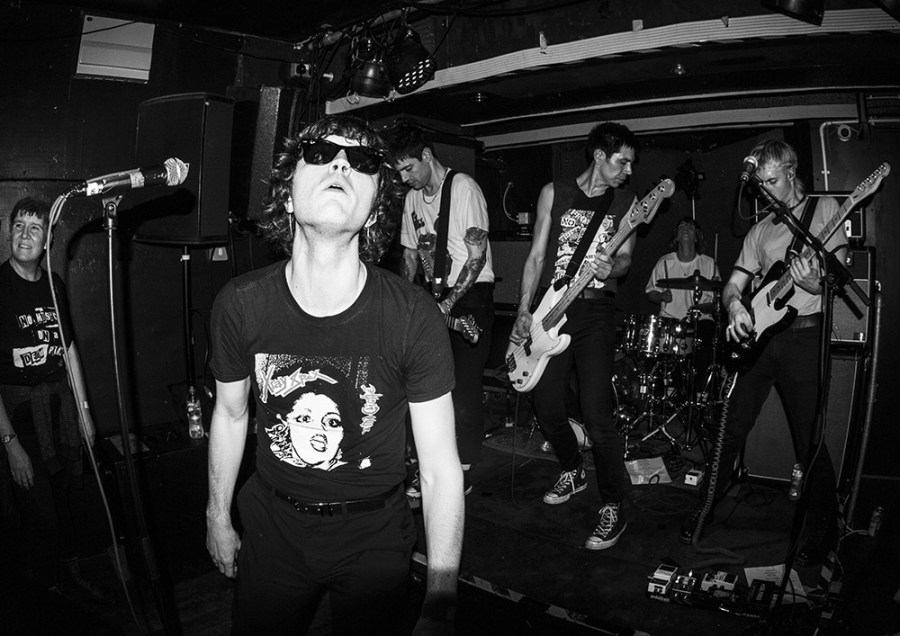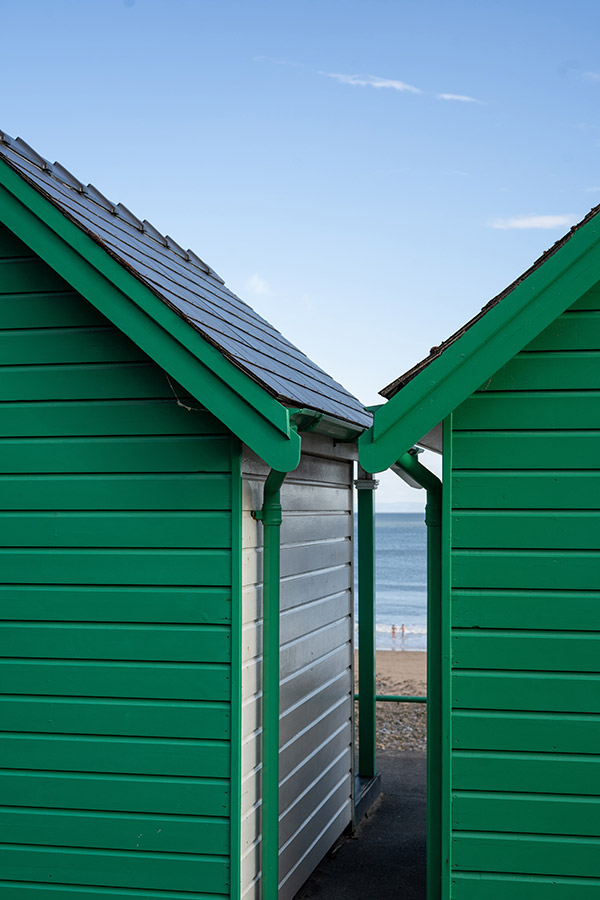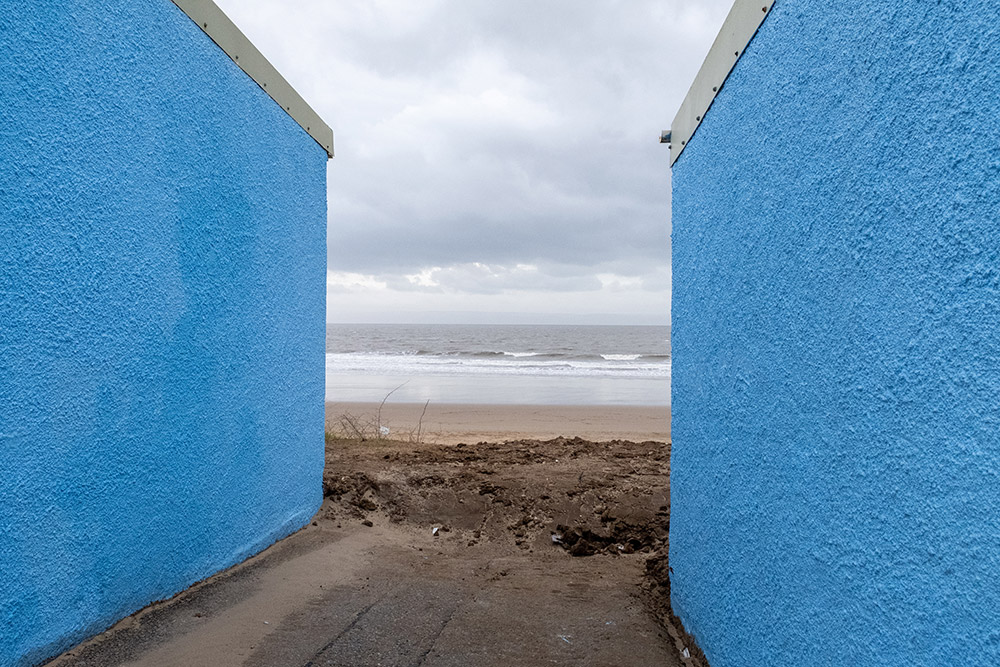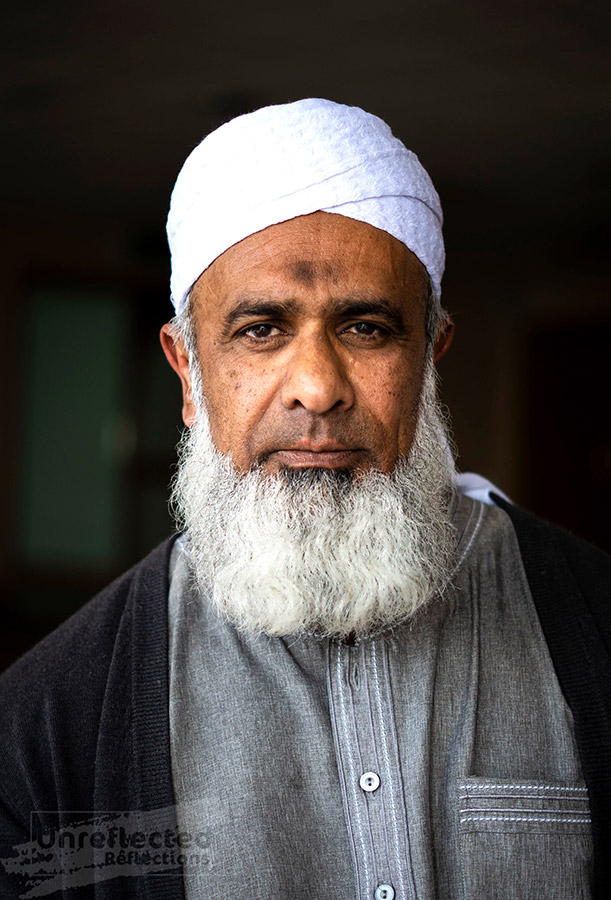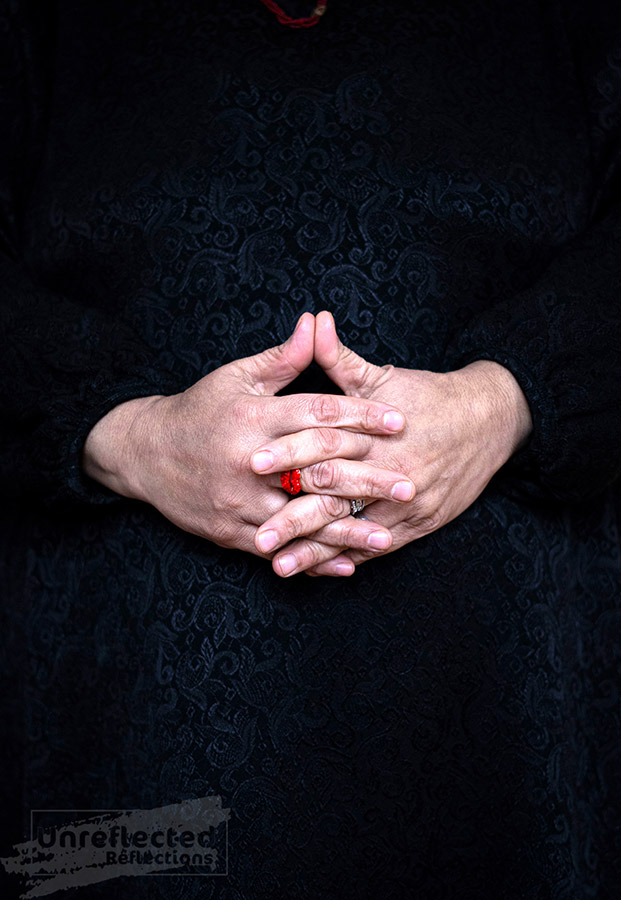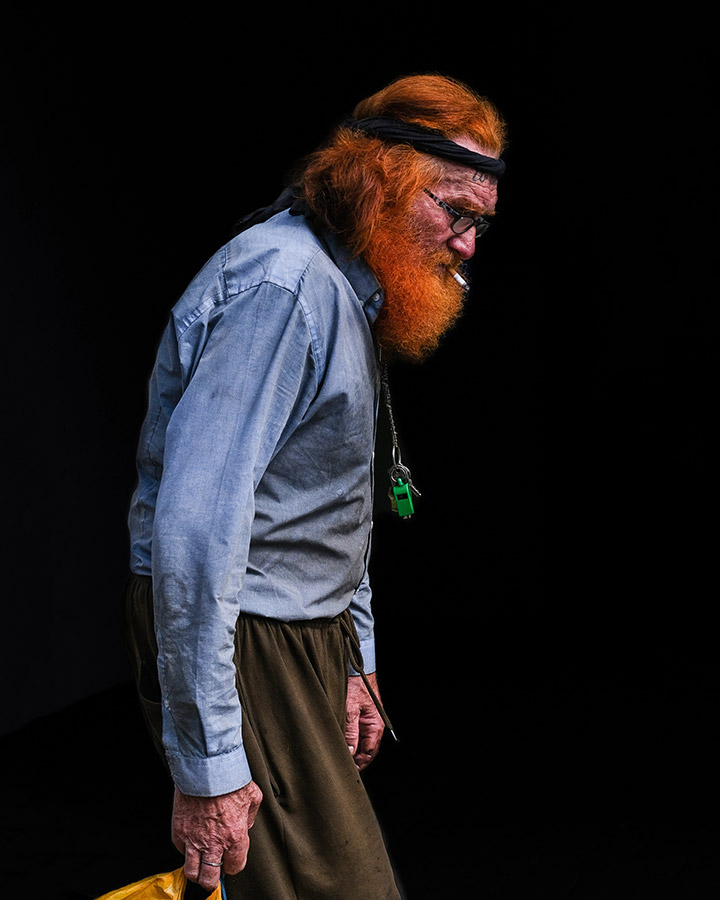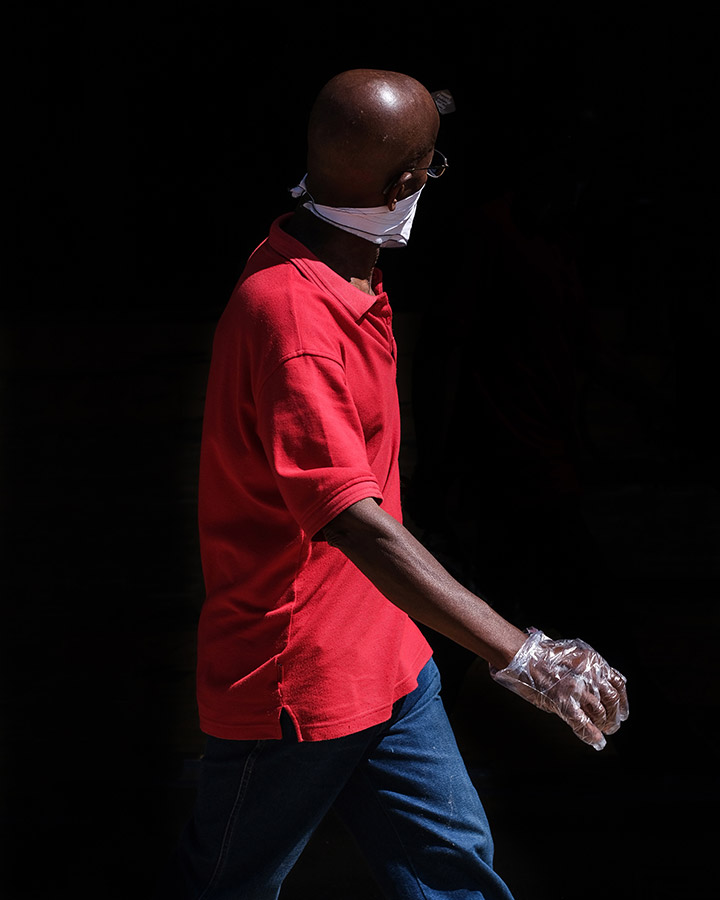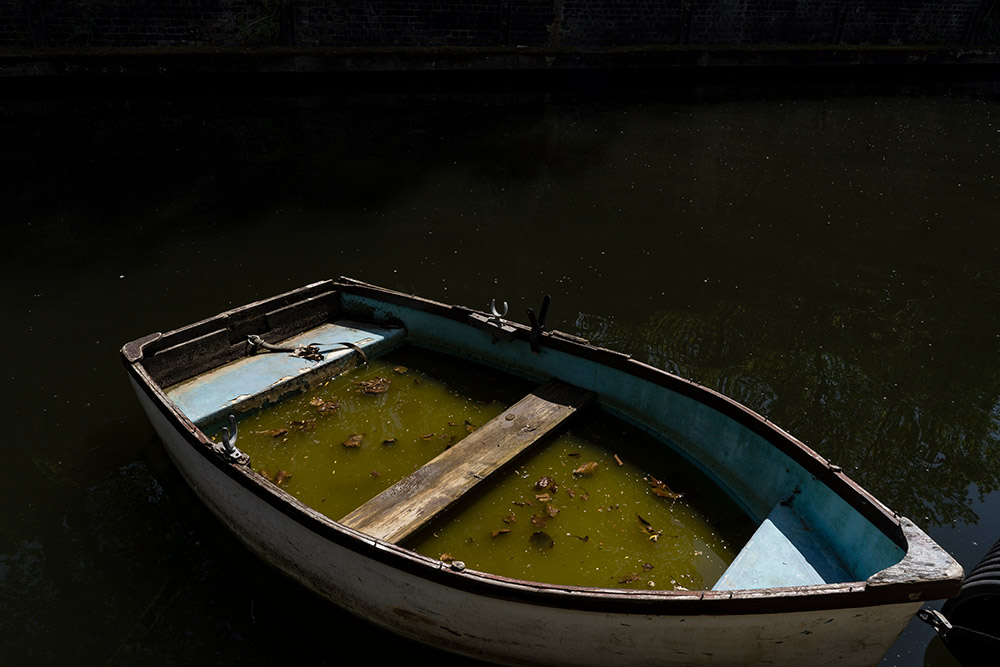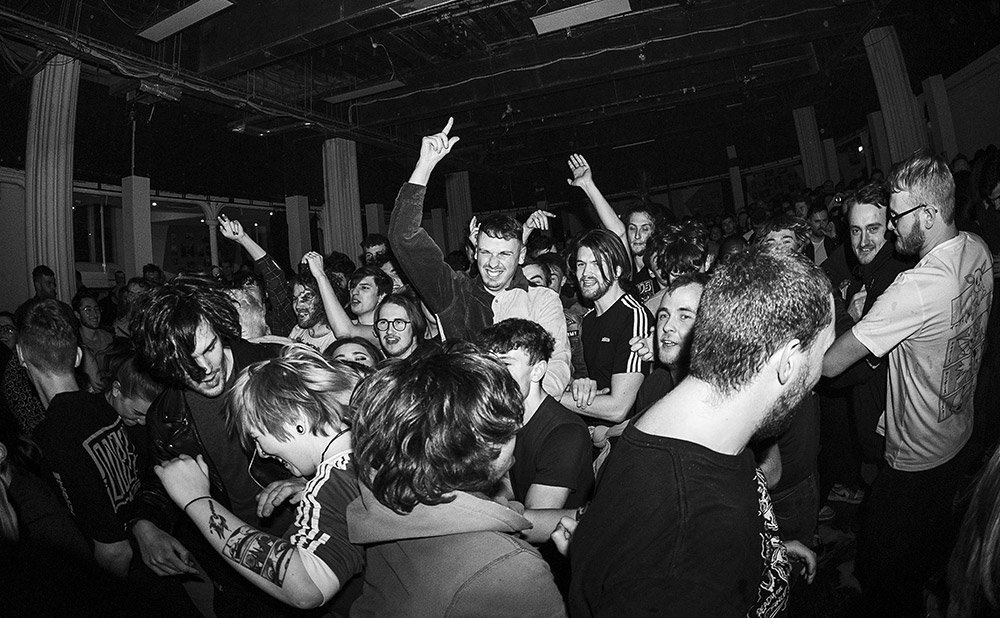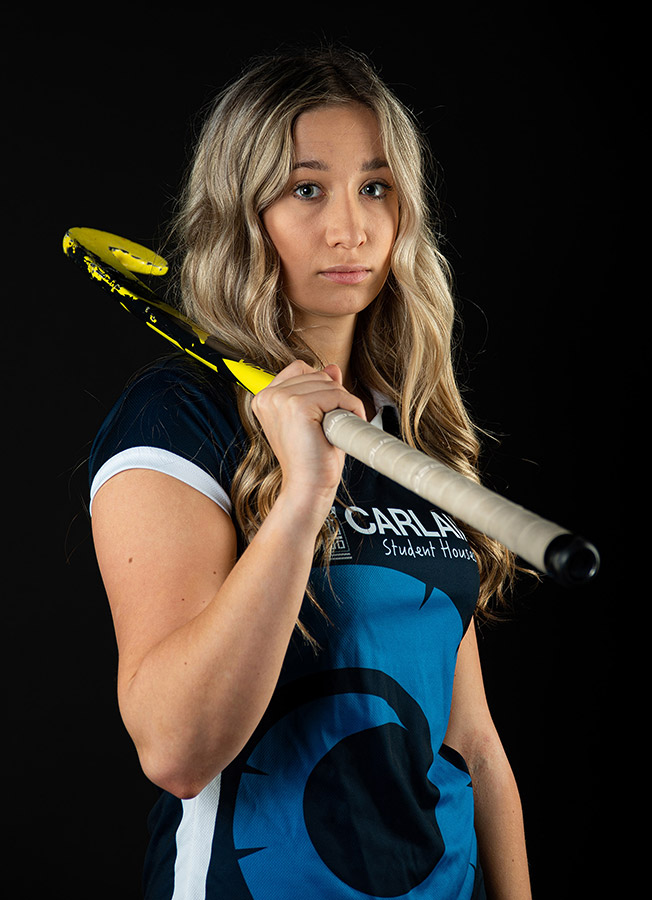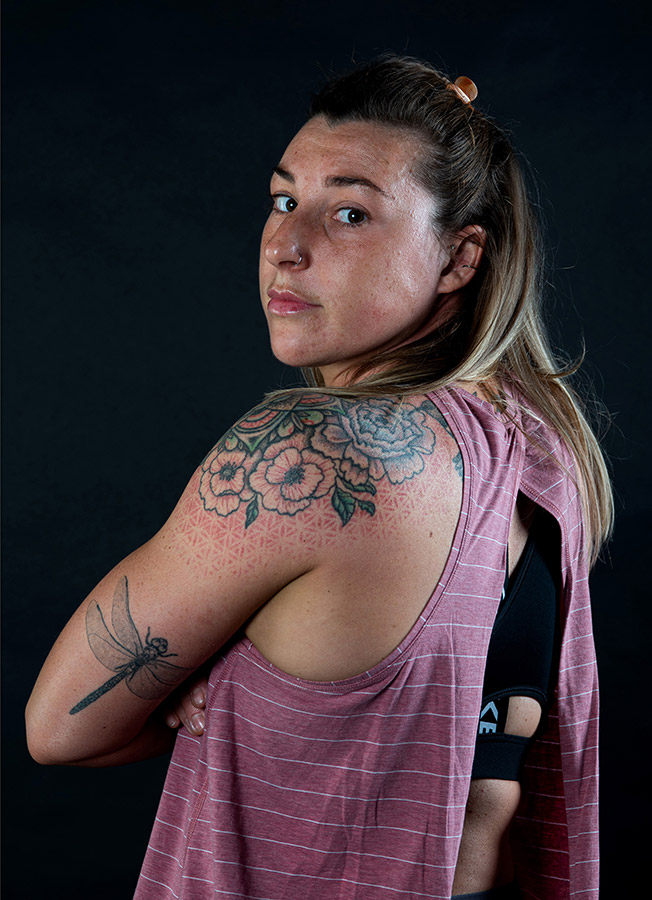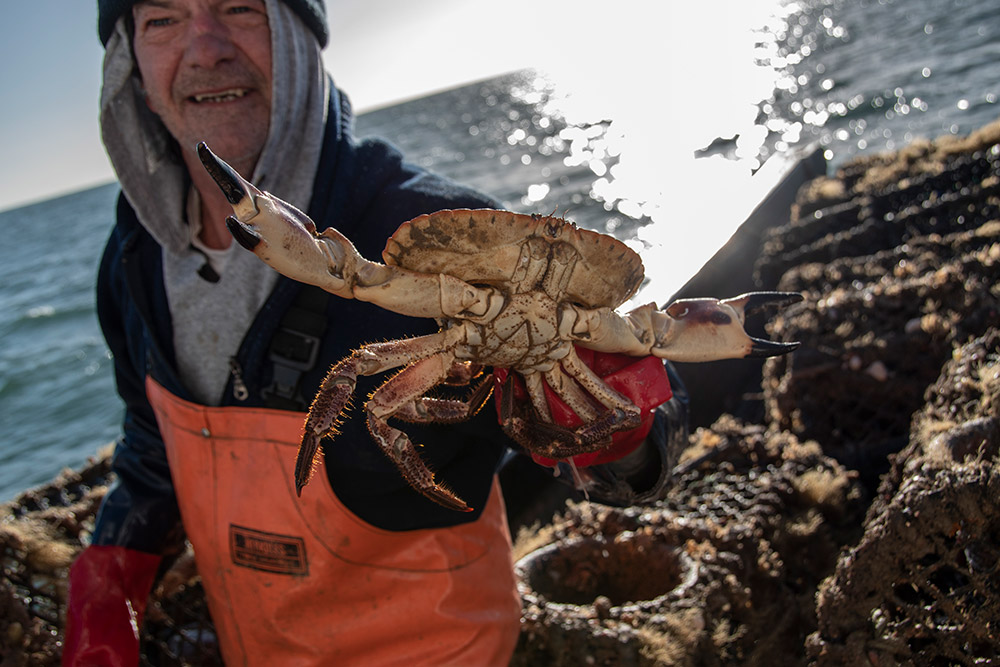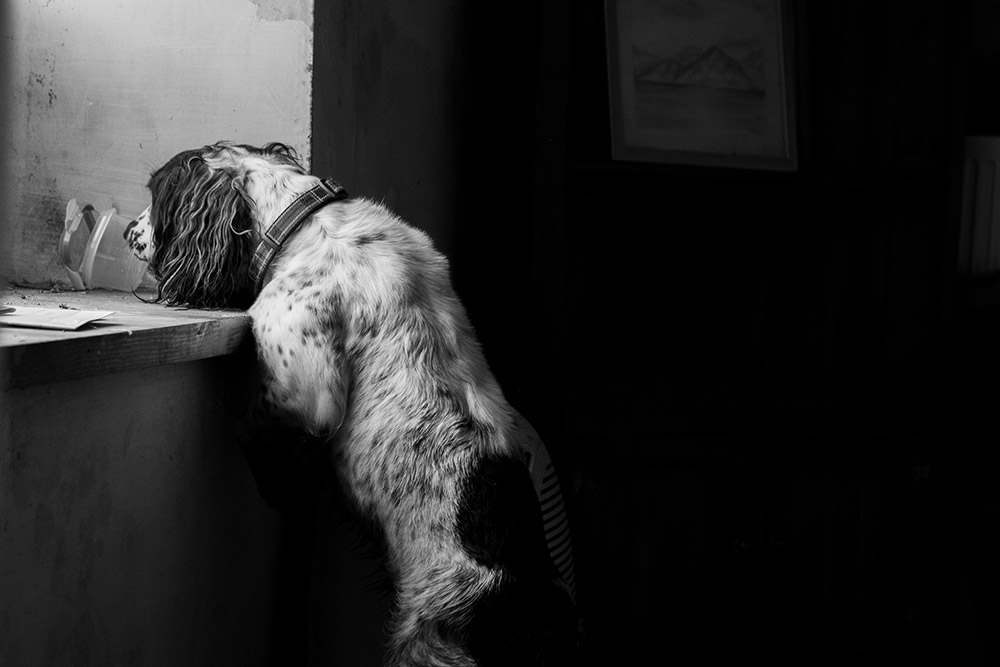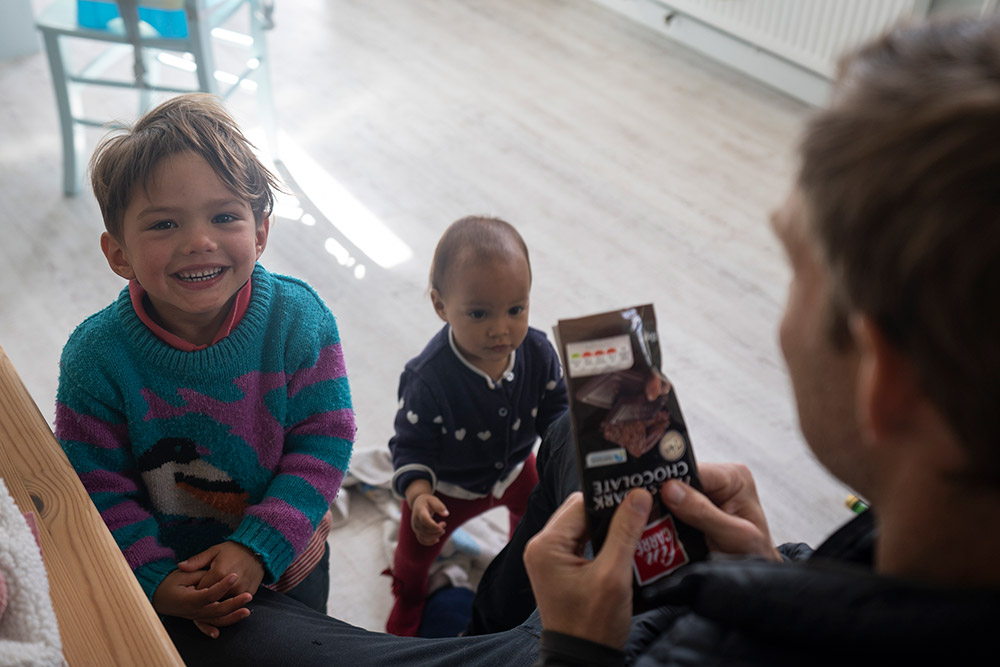Jessica Miller visits Perspective, the degree show by Final year BA Hons Photojournalism and Documentary Photography students from the University of Gloucestershire. The students share more about their projects and advice for those looking to get into photography.
The Summer degree show… a milestone in any creative arts students’ university career and an exciting opportunity to present their work to the public in what is quite often their very first exhibition of work. A lot of effort goes into these shows behind the scenes, from the development of ideas for your individual project, creating and curating your work through to arranging the exhibition space with your peers, fundraising and installing the exhibition ready for assessment and of course, the punters! It’s a period that can be demanding but incredibly rewarding. Yes, I speak from experience.
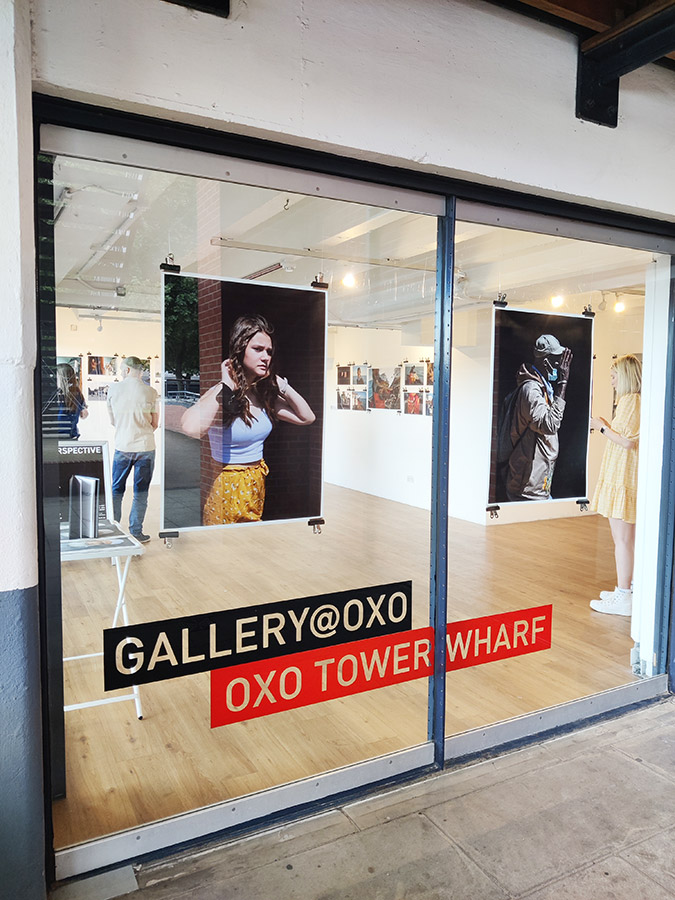
University of Gloucestershire Degree show a gallery@oxo. Images displayed in the window: James Bleasdale
This year, we are visiting some of the undergraduate and postgraduate shows around the country to take a look at and celebrate the work of a new generation of photographers. At the end of May, I visited University of Gloucestershire’s BA Hons Photojournalism and Documentary Photography degree show, Perspective, on show in London at gallery@oxo.
19 photographers had their work on display and images were selected from larger projects, presenting a collection of diverse photo stories encompassing social documentary, portraiture and journalism. From Elvis Tribute Acts to the fishing industry post Brexit.
I spoke with some of the students about their work, inspirations and future plans as they conclude their studies:
Christine Vassaux Noe
Canon EOS RP mirrorless and full frame camera for all the images and used only a 50mm and a 28mm in the project.
Can you tell me about yourself and your project?
I’m 27 and I’ve grown up in Denmark, but is half French and half Danish. I just moved back to Copenhagen, where I also lived for a few years before moving to the UK to do my degree.
I have wanted to do this project for a few years, but the opportunity just hadn’t presented itself. I have always loved rural France, but seeing how the small communities are struggling and having experienced how it has affected my family’s life as well has made me want to document their daily life and the villages daily life as well, trying to focus on how isolated these communities get and how it is nearly impossible to change the direction they are going in.

Closed restaurant. The only café/restaurant that was left in their little village has closed. Image: Christine Vassaux Noe
How did you choose which photographs would be included in your show?
It was a really hard decision actually. First of all I wanted to create a balance between documenting my grandparents daily life and the state of the village. So I went with portraits of them in their house and images from the village showing how empty it is also becoming.
What are your future plans?
I have already started my business as a freelance documentary photographer. So hopefully I am going to photograph everything from more events, portraits, stories etc. than I am already doing.
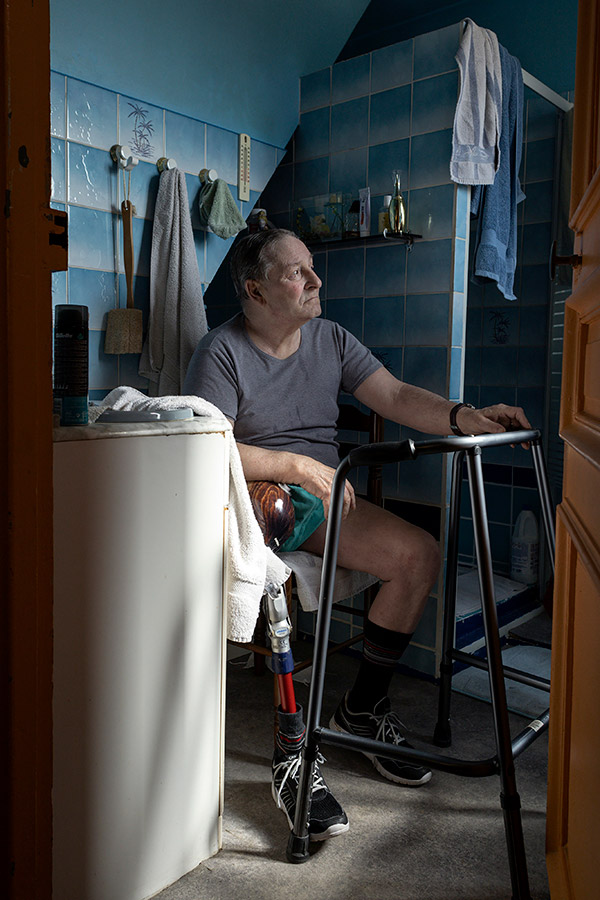
Papi. My papi sitting in the bathroom after getting ready, as he does every morning, waiting for my mamie to come help him get down the stairs and get dressed. Image: Christine Vassaux Noe
Do you have any advice for others wanting to get into or study photography?
- It’s a really hard field of work to succeed in, so don’t necessarily jump straight into a degree in it before having actually thought about if this is something you really want.
- Start out spending some time with a camera in your hand, photograph the things that interest you and figure out which type of photography that speaks to you.
- If you honestly feel a passion for it, just go for it!
Emily Williams – Circular
Canon EOS 50D, Canon 50mm F1.4 lens. In the image of Max from Plur vintage a Neweer TT560 Speedlight is also used.
Can you tell me about yourself and your project?
My name is Emily and I’m originally from Devon. I’ve been taking photos, mostly portraits, for as long as I can remember but it was not really until the second year of university that I realised I was really interested in fashion documentary photography, so I began shooting projects I was more passionate about.
Recently I’ve developed an interest in sustainability and I knew I wanted my final university project to be fashion based so I thought this was a perfect combination. Initially I did lots of online research about the effects the fashion industry has on the environment. After watching the documentary, The True Cost, I knew I wanted my project to be somewhat educational, so I decided my final piece would be a magazine targeted at young adults.
A big inspiration to my project was Jenny Lewis’s book Hackney Studios, which photographs London creatives in their workspaces. I loved how Lewis positioned the subject, allowing them to be viewed in relation to their space but not taking away from the interest of the subject.
How did you choose which photographs would be included in your show?
The portraits in the show were my favourites from my project which had a big influence on why I chose them as I wanted to be really proud of the images I put on the wall.
What are your future plans?
Right now, my aspirations are to be a visual merchandiser and ultimately a stylist, so I’m taking steps towards this. In September I hope to begin a diploma in fashion styling. I’m still going to be doing photography on the side like photographing family events. I also would like to continue shooting my own personal projects as well as revisiting a previous project and continuing that.
Do you have any advice for others wanting to get into or study photography?
- Don’t be afraid to experiment. Before coming to university, I only ever shot in black and white because I was very comfortable with it. My modules helped me step out my comfort zone and now I love shooting in colour.
- I also think it’s important to have a portfolio you are proud of when applying for a photography course so you can take real pride in the work you are showing prospective lecturers; owning your work is something we always got told to do throughout our course.
- Looking back to when I applied, I rushed my portfolio, and it did not have work in it that I loved. Now I am confident my portfolio showcases my best work and shows who I am as a photographer.
Evie Hitchings – 870 Miles
Can you tell me about yourself and your project?
My name is Evie Hitchings and I am a documentary photographer from Gloucester. With my recent body of work, titled 870 Miles, I wanted to explore my interest in documentary and travel photography. After being given complete creative freedom for this major project, I decided to research into specific routes and journeys that I could embark on and document through a road trip style.
The Welsh Coast was the route I decided to adventure, it was a no brainer for me that I would travel in my camper van- I was also very much intrigued as to how I could incorporate and use the van as my studio.
I am lucky with this subject matter of a ‘road trip’ as there have been many famous photographers documenting American road trips, for example, Stephen Shore’s ‘American Surfaces’. By gathering inspiration from many different photographic styles found in American Road trips to rural British landscape journeys (the works of Dan Woods- ‘Gap in the Hedge’), I was able to create a much more well-rounded photographic vision for my work.
How did you choose which photographs would be included in your show?
By visiting different beaches and coastal towns one-by-one, I was able to see and create comparisons, this enabled me to be able to create a portrait of the places. The process of selecting final images for our London Degree Show was one which took time, going from producing a photo book with over 40 images in, telling a story of a road trip, choosing a handful was tricky.
However, what I have and did find extremely helpful is the opinions of those around me- professionals who I contacted for feedback and my classmates, these opinions were vital. Together we were able to select five photographs that worked well together and showed an outline of my project intentions- looking in to colour, layout and sequence was very important. The five images I chose for the show are strong enough to stand alone but also work well as a sequence.
What are your future plans?
Over the past few months at university I was able to begin networking and meeting with other creatives working in both photography and film, I have had great insight and advice. My plans going forward, backed with what I have learnt recently, are to push myself into the world of travel photography.
By combining and reigniting my love for photography and travel, I know I will be able to push myself out of my comfort zone to create strong photographs that can be showcased through an online travel blog which I will be working on. From here, I aim to build a following online in order to freelance whilst travelling- this is the long term goal/ dream!
Do you have any advice for others wanting to get into or study photography?
- Always keep an open mind – knowing areas of photography that interest you but also not limiting yourself to these categories. Explore studio photographic work, but also practice your street photography, this is the best way to figure out what really excites you as a photographer.
- Another key thing that I have found extremely beneficial and am really seeing improvement within my own work from, is the constant critique and feedback from everyone around you– even if they are not photographers themselves.
- Printing your work out and asking professionals or classmates to annotate, is extremely helpful- this way you are constantly reflecting and looking for ways to improve your creativity within photography!’
Isabel Lussana – Unreflected Reflections
www.isabellussanaphotography.com
Sony A7 III with a Sony 50mm for the portraits and a Sony 18-135mm lens for the landscapes.
Can you tell me about yourself and your project?
My name is Isabel Lussana and I am originally from Italy. I moved to the UK about three years ago, right before the start of my BA in Photojournalism and Documentary Photography at the University of Gloucestershire. I’m a documentary photographer and what I focus on the most in my work are portraits.
This project started about two years ago in the mind of one of the members of the community. After his grandfather passed away, he realised that he had only ever seen him as a grandfather, and he never really sat down and asked him what his story was. His grandfather was among the earliest members of the Muslim community in Gloucester, and he saw that a lot of them were passing away before they had the chance to pass their stories on to the next generation.
He realised how important it was to record the history of their community from the people who lived through it now that he still could. The project he had in mind was divided in three parts: a photography exhibition, a short documentary and a written report. He approached the photography department at my university and that is how I learnt of it.
I was inspired by his wish to record their own history and I really wanted to help him do that, so I decided to get involved in this project. I started shooting in January and I finished around the end of April, but I feel like I could have shot this project for a whole year, and it wouldn’t have been enough to cover years and years of history. It definitely feels like this will become just part one of a much longer project.
How did you choose which photographs would be included in your show?
For this project, I took a mix of portraits of some of the people who helped the community grow into what it is today and landscape images of some of the buildings that were established so that faith and cultural related needs of the community could be met. My speciality is portrait photography and I personally think that it’s easier for the viewers to empathise with portraits rather than landscapes, so this is why I chose four portraits for the exhibition.
However, some of the landscape images I have taken were quite strong as well, so I decided to include an image of the Mosque and have it in the centre in order to symbolise how central faith is in the lives of the members of the Muslim community.
What are your future plans?
I have applied for a masters in Documentary Filmmaking at UAL and I will be starting in October, but I do hope to keep working on this project if we decide to continue it.
Do you have any advice for others wanting to get into or study photography?
- If you are considering photography as a career, don’t be afraid of failure, because that’s the only way you are going to learn.
- Secondly, don’t be afraid to put yourself out there and go after opportunities. Be proud of your work and ask for feedback. The more you shoot, the better you will become.
Is there anything else you would like to tell us ?
My work is currently being exhibited at the Friendship Café in Gloucester. It will be up for one more week, so if you are in the area feel free to go check it out!
James Bleasdale – Northern Lights
www.jamesbleasdalephotography.com
Can you tell me about yourself and your project?
I’m now 21 (20 as of the degree show) and I grew up in Huddersfield. My speciality is street photography thanks to its ever-changing nature. However, the field which I now wish to progress in is the genre of documentary photography.
In December of 2019, the first case of the Coronavirus was identified in China and by 2020 the world was on full lockdown to reduce the spread of the newly named COVID 19. On the 31st of October 2020, Prime Minister Boris Johnson conveyed the rules for lockdown 2 to the nation which stated that people should only leave their homes for medical purposes, for limited outdoor exercise and to purchase food.
Northern Lights started as a project to capture those making these journeys and continued as a series of street images shot during the lockdown 2019-2021 in Huddersfield. It was shot outside Marks and Spencer’s – that typical landmark from every British town or city shopping street and shows the everyday comings and goings of its multicultural population as they manage their lives around the COVID 19 restrictions.
To capture the project, I used a Fujifilm X-T3 with an adapter added that allowed me to use a recently purchased SMC Pentax-M 50mm F1.7, allowing me to better shoot street but with the limit of only manually focusing my images which actually proved beneficial. I also added a Fujifilm VG-XT3 Vertical Battery Grip to make my long sessions of portrait shooting less taxing on my wrist- since I was shooting at around 4 hours a day.
Tell me more about how you chose to display your images
For the show I chose to display my images in the windows of the gallery. Firstly, because it was the largest space to display work with most other people choosing to use the white wall space instead to catch the natural light and boarder their images.
But I also did this because they would be the first images that passers by saw when they look at the gallery. By setting these images at head height, I hoped it would make passer-by’s feel as if they are passing these people in the street and drawing them into the gallery to view everyone else’s work. I also had prints on the reverse side inside the gallery.
What are your future plans?
As part of my final major project at the University of Gloucestershire, I had developed ideas, research and connections over two other projects which I didn’t get to pursue further. These are definitely areas which I wish to revisit!
The first was to travel to Northern Ireland and document how the Troubles, a conflict between the 1960’s-90’s, unfolded and the legacy it left behind as well as a resurgence with the disruption caused by Brexit. This would not only follow the tours of veterans that served in this war but also the current situation where ‘peace walls’ still divide entire cities.
With my other project I was planning on working with an aid relief charity to follow its line of distribution from families sending boxes all the way to the people receiving these items still on the front line of the conflict, i.e. in Ukraine.
Despite the fact that this subject has been covered massively and become “old news within the media”, I still want to cover it as the issue is still ongoing and my later visit acts as a reminder that this tragedy is still going on.
Do you have any advice for others wanting to get into or study photography?
- Pick up a camera, look through the lens, ask yourselves what it is you want to capture and if you are passionate enough about what that is to keep going.
- Photography projects can take a long time to develop – and that’s just in the shooting phase! I allowed myself to be disappointed when I didn’t get the shot of the old woman who stepped out of focus at the last minute and overjoyed at the shadows falling perfectly, which helped me improve on future shoots.
- If you are thinking of going into the course, expect to both produce lots of work and present it in front of others in the class regularly.
- Photography is a subject that requires a lot of drive and effort to build your practice and succeed in it.
Is there anything else you’d like to tell us about yourself?
Finally, on my website you can find all of my work so far as well as a contact section where you can ask questions about my work, contact me about buying prints or my book Northern Lights- as well as if you have any connection to my future projects in any way then I’d love to hear from you and be able to set up a call if you want to talk on a more 1-2-1 basis.
Jess Knight – Walk a Mile in my Shoes
All photos were taken on a Canon EOS 6D. 1 and 3 were taken with a Canon EF 50mm f/1.8 STM lens. 2 and 4 were taken on an EF 24-105mm f/4L IS USM lens.
Can you tell me about yourself and your project?
I’m a 21-year-old Photojournalism and documentary photographer. I have spent the last 3 years studying all sorts of photography at the University of Gloucestershire which really allowed me to focus on learning new techniques and skills and really figuring out what sort of photography I like and what kind of photographer I could be in the future.

1. Starting young at 11 years old, Enzo is captured in his favourite Elvis outfit in his home in Manchester. Image: Jess Knight
I have photographed all sorts of subjects from students on nights out, to looking at and photographing the relationships between mothers and their children to now really finding a passion in photographing Elvis Tribute Acts (ETA). I have such a love for photographing people and this type of photography really grabs my attention. I love getting to know my subjects and really forming a relationship with them, I feel like that is a big perk of being a photographer!
My project actually formed quite unexpectedly. In 2021, I had a stressful few weeks where I spent ages trying to figure out what to photograph for one of my university assignments, everything seemed to keep going wrong and I just wasn’t happy with the work I was producing. One day we had Clementine Schneidermann come in and speak to our class about her work.
She had a project called ‘I called her Lisa Marie’ which was all about Elvis Tribute Acts. I mentioned that my family were big fans of Elvis and go to these Elvis Tribute Act events. My teacher told me to just focus on that and start photographing my family and really explore their love for Elvis.

2. Two Elvis Presley Tribute Acts walking out of the green room getting ready for their performances at a Porthcawl Elvis event in March. Image: Jess Knight
Over the following weeks, I spent time with my parents, my uncles and cousins photographing them and their homes, talking to them about why they love Elvis so much and just really indulging myself in the Elvis ‘fandom’. I fully fell in love with the concept and as January crept up and we had to start deciding what we would photograph for our Final Project. I got into contact with some of the Elvis Tribute Acts and organisers of Elvis events and everything slipped into place from there.
I spent 4 months going to different events, forming bonds with the acts, and visiting people at their homes. I really surrounded myself with all things Elvis and I absolutely loved it. I even went to Malta to visit a Tribute act there which was pretty crazy! Everyone was so supportive and welcoming of me and this helped with my journey and progress a lot!
So, my inspiration definitely came from Clementine Schneidermann as well as my lecturer who helped support me and cheer me on during the stressful few weeks in 2021. My parents particularly my Dad inspired me a lot as well, having grown up surrounded by Elvis memorabilia, music and trips to Graceland to visit Elvis’s home, I can now truly understand and appreciate why my parents love him as well as the Elvis Tribute Act events so much!

3. Welsh Elvis Tribute Act Kirk stood in the valleys near where he grew up and where his act began. Image: Jess Knight
How did you choose which photographs would be included in your show?
Picking a limited number of images for the exhibition was quite difficult. I had a lot of images from all the different events which made it a lot harder. However, there were images that really stood out to me which made selecting a few a little easier.
I knew that I wanted to include a good mixture of different types of images to really tell the story through only a limited amount of images. The images I picked do this as they show some people in a home environment through staged portraits, as well as some more candid behind the scenes images that people who aren’t in the tribute acts get to see and some that show the connections between tribute acts and audiences which I really loved to focus on. The photographs really look at different aspects and show a different part of the ETA world within.
What are your future plans?
Luckily for me, I fell so in love with the ETA world that it is something I would love to continue all throughout my photography career. Moving on from University I am going to America in July to be an Au Pair in Colorado for a year.
I wanted to do something completely different and didn’t want to go straight into a conventional job. I wanted to take time out to travel and do some exploring until I feel like I am ready to jump into the photography world. I will definitely still continue this Elvis project in America and go to some American events and meet American ETAs. After that, I am not really sure where I will be but that’s what is exciting.

4. Behind the stage at the Harbour Lights Festival in Weston-Super-Mare where multiple acts are getting ready for the stage. Image: Jess Knight
Do you have any advice for others wanting to get into or study photography?
- Try not to be specific on what you want to do straight away. Don’t rule anything out and just spend time exploring lots of different types of photography and subjects because it might really surprise you!
I went into university wanting to be a War photographer and now I am leaving with a massive passion for photography Elvis Tribute Acts! Just see where things take you and just enjoy learning new things and meeting new people.
Kamal Jobanputra – Regent’s Canal
Sony A7 III, 28mm lens
Can you tell me about yourself and your project?
I studied Photojournalism and Documentary Photography at the University of Gloucestershire. Although I studied in Cheltenham I am originally from Hertfordshire. My project follows Regents Canal which is 8.8 miles long, the canal spans across London from Little Venice in the Borough of Westminster leading to Limehouse in the Borough of Tower Hamlets. This is where the canal leads into the Thames overlooking Canary Wharf on the left and the Shard on the far right.
I shot the project from February 2022 to April 2022 and I am aiming to continue shooting and expand the project over the next few years. I gained a lot of inspiration from Alec Soth’s Sleeping by the Mississippi, Sarah Lee’s Sidewalk America and Robert Frank’s The Americans.
The reason as to why I wished to photograph the canal is because when I was younger my Father would take me to visit and I have very fond memories of these days. As well as this, I find the canal to have so much historic meaning in the city, it was key for transporting goods in the 19th and 20th centuries (especially during wartime) and there is still evidence of this usage.
Now the use of the canal has changed, as people use it for leisure activities and there are many people who live on it and alongside it. So, my aim was to document this, and show how although the canal spans across many varying areas with people of different backgrounds, it is in fact the connection between these people who reside in London.
The images I decided to use in my degree show show the variety of lifestyles along the canal, and show the canal itself, linking the people together. Another reason as to why I chose these images is that they show what one may come across when walking the canal, as I would like the viewer to almost come on the journey with me.
What are your future plans?
In terms of my future, as I have said I am willing to extend this project over the next few years with the aim of creating a book and then moving onto another long-term documentary project. Although I am extremely fond of documentary photography, I have a great interest in journalism and I am planning on doing a Masters in it.
With this degree the aim is to go into broadcast journalism or podcasting as well as working on my photography alongside my studies and future career.
Do you have any advice for others wanting to get into or study photography?
- One thing I have learnt and would advise anyone who is a current student of photography or someone who is willing to get into it and not sure where to start is, shoot what you love. With this project especially I realised that as I love history, water and photographing lifestyles, I found myself to greatly enjoy shooting it and the end result was very good.
- Shoot something that interests you as you will not give up and feel inspired to create an amazing body of work.
Lauren North – The Pit
Canon EOS 5D Mark III, Canon EF 24-105mm L series lens, Canon EF 50mm f1.4 lens, Canon EF 8-15mm 1.4 lens and a Canon speedlight.
Can you tell me about yourself and your project?
I am 21 years old, currently shooting freelance gig photography. I am currently based in Cheltenham but will be returning to my hometown of Spalding for a while. I specialise in concert photography but have shot events such as weddings as well as dance shows and competitions.
The Pit is a documentary project exploring the small gig scene in the West Midlands. Photographing bands such as Don Broco, Cleopatrick, Yonaka and King No-One, the project documents the performances, venues and fans who attended these smaller gigs, a world away from arena and stadium tours of established artists.
The Pit shows how concert culture is very much still alive following the COVID crisis, with small venues reliant on continued fan support, of these small bands they continue to exist as ‘independent’ on the tightest of budgets.
How did you choose which photographs would be included in your show?
Choosing the images for the exhibition was tough as the project overall included 35 images so selecting 6/7 that showcased the work best took some time and opinions from my peers. I ended up picking the images I did as I felt that they portrayed the whole project best using a mixture of crowd shots as well as Shots of the performances, allowing the viewers to have the best visual of what being at all of these concerts was like.
What are your future plans?
Currently I am still in Cheltenham for another month before I move back to Spalding. I am going to continue to photograph bands in the Midlands with the hopes of travelling in the near future to Australia to continue shooting on a working visa.
Do you have any advice for others wanting to get into or study photography?
- Experiment with different styles and find what you love doing. It took me a year or so to really get into concert photography but once I started shooting gigs I quickly fell in love with it and have been shooting them ever since.
- As for studying photography I think it is such a great subject to take as you learn so much about the industry, equipment, communicating with other photographers and many more important factors about the world of photography, it is also so fun photographing different events and doing all the tasks set for each module.
Louisa Hill – Women in Sport
Can you tell me about yourself and your project?
I am 21 and from Bristol. My project Women in Sport is about the women in the sports industry. As a sports player myself, I have grown up seeing the industry being dominated by men. The inspiration behind my project was the lack of women representation that there is in the sporting world.
The project focuses on women only, to highlight the sports they can play with no limitations for what they can do, hoping that it will inspire women of all ages to go out and achieve the goal they were aiming for.
To achieve this project, I got in contact with a variety of different sports. I spoke to footballers, dancers and even a young fencer. The variety that I captured was amazing. No two sports were the same, and I think having each sport different from the rest displays what women can do.
I created studio portraits of the women, in their sporting clothes with equipment from the sport if they had any. The lighting set up was simple yet effective. From my time at university, I had always been told how sport photographs in the studio needed dramatic lighting to highlight the tense sport.
I took this advice with me throughout the project and created a 3-light set up on a black backdrop hoping it would add a mood throughout the images. If the girls had equipment with them, I would get them to pose with it, using it as props.
In some of the images, the equipment was posed in action, whereas in others they were at rest. I liked the variety of this and I felt it was interesting for the viewers to see the equipment in a different way compared to how they would normally see it in the sport.
How did you choose which photographs would be included in your show?
I firstly thought about the size I would be printing. In our lecture we measured out the gallery to scale, and worked out how many images fitted on the wall for each person.
If printing A1 then we could only have a maximum of three. The smaller you printed your images, it meant that you could have a wider variety to hang on the walls. I decided on three A1 images. Knowing the size that I was doing; I made some mock examples of potential set ups that I could print.
I was torn about having the three images of the same sport, or all different. I decided on having the images different as it would show a variety of what my project was about. By doing this I felt like they had to be of a similar style, e.g. all full-length body images or headshots. This was so that the head level was the same throughout the images when on the wall, having one off would make my sequence look different which I did not like. I narrowed down my selection to the hockey player, the women with weights and the CrossFit women.
What are your future plans?
I want to stay in the creative industry in some sort of way. This could be as a simple hobby that I do on the side or to go straight into the arts industry. At the moment I have no set plans as this is a big decision to make after university.
I am potentially looking at going into education and helping younger artists gain the skills that they will need to grow in the future. I do love to travel however, and since things are getting back to normal, I am hoping to get back on a plane somewhere with the camera.
Do you have any advice for others wanting to get into or study photography?
- I would say that if you are looking at studying photography, then simply learn the basics first. Learn how to operate your camera, learn the key techniques in a photograph. This way you are ahead, and you can get started on your projects without worrying about working the equipment.
- The extra tips you learn along the way, will then help you evolve as a student throughout your time. I would also say photograph as much as you can. Ask your parents to pose for portraits, photograph as many trees as you possibly can do.
This way you are building your knowledge, knowing what works best for you as a photographer. One way I achieved this was by completing a 30-day photo challenge. It was hard but it made me think about capturing something different each day. But also taking my camera with my everywhere, because you never know when you might need it.
Anything else you’d like to tell us?
I like having a meaning behind my work. I find it really hard to develop a project with no meaning. In previous projects I have looked at bullying, human neglect, and even the differences in two countries. I think having a strong meaning behind the work helps you as a photographer progress further.
I also like to be knowledgeable about the topic I am photographing. Researching my subjects knowing the key information can help the viewers understand your project more as you have showed it for how it is
Lucy Harris – Sold by the Kilo
Nikon D5600 camera with a 18-200mm lens and a Nikon Flashgun for all images
Can you tell me about yourself and your project?
I have just finished my degree in documentary photography and photojournalism (wooo). As a child, I was always fascinated by learning new things, not necessarily at school, but through documentaries and quizzes, with a particular interest in Bear Grylls, Hostile Planet, and David Attenborough’s Planet Earth.
I loved to see them in places that I couldn’t even imagine being in, learning about different species of animals and plants that I had never heard of. This sparked an interest in me for wildlife photography and is where I began taking photographs.
Usually photographing while on holiday I was able to spend time thinking about the image, the composition, the lighting, and how it would come across to other people. I have always found a joy in being able to show someone something that they might not have been able to see unless it had been photographed.
When I joined this photography course I always had in mind that I wanted to continue to document things that you wouldn’t see in the everyday, this started off by me photographing firefighters and what they do when they aren’t fighting fires as well as documenting the process of lambing season at a local farm.
After a year and a half of my photography course, I noticed a recurring theme within my photography: hardworking men in practical jobs. My aim with every project is to learn about a topic that I don’t know anything about and hope that within my photographs I also teach other people new things. For this particular project I wanted to photograph a topic that had caused recent media attention.
With the UK officially leaving the EU in January of 2020 there had been a few years to see the effects of the Brexit decision and which industries it had affected the most. Commercial Fishing has been impacted greatly due to Brexit, and many of the fishermen felt as if they had been ‘sold a lie’ during the referendum as they were assured leaving the EU would liberate them from the laws imposed on them when in fact it has done the complete opposite.
I wanted to learn about how these changes affected a small-scale commercial fishermen, which then led me to Mark. Mark is a Lobster Fisherman from Poole, has been fishing commercially for over 40 years, and is now on the brink of retirement. Mark was kind enough to invite me on his boat to document the process of his day as a fisherman post – Brexit.
How did you choose which photographs would be included in your show?
For the submission of my project, Sold by the Kilo, I created a printed portfolio of 24 images, these document a day in the life of Mark and all the factors this intel’s, as well as following the lobsters he catches to the local fishmongers. You get to see an in-depth story of what life is like for him.
I wanted to create the same effect but with limited space. Creating an impact is always the top goal when exhibiting images, you want people to notice your work immediately. You also want to make the most of the space you are given. I decided the best way to draw attention to the image was to print one very large image, I chose an image of Mark holding a crab in the foreground, with Mark out of focus in the background taken during the morning sun.
Once I had decided which image would be my power image, I then had to choose other photographs that I thought would help to tell the story of the project. To make the display even I decided to have 4 A3 images on either side of the A1 image of the crab. These images were taken throughout the documentary and show some of the tasks he gets up to in his day, I also wanted to show Mark’s personality through a portrait taken of him.
What are your future plans?
I have really enjoyed my degree and it has shown me how enjoyable not only documentary photography is but also commercial photography. I currently don’t have any rigid career plans for my career, I just want to enjoy my few years after graduating by traveling to new places, experiencing new things, and documenting it along the way.
Do you have any advice for others wanting to get into or study photography?
- The best thing you can do to get into photography is to take your camera with you wherever you go, it doesn’t have to be expensive or the latest kit but having it with you gets you used to the feeling of constantly thinking like a photographer. It also allows you to photograph things as you see them, as you may never get the chance to take it again.
Rachael Adams -HEDDLU
www.rachaeladamsphotography.co.uk
Canon EOS 7D with a Canon EF 24-105mm f/4 lens and also Canon EF 100-400mm lens. Edited in Adobe Photoshop 2021
Can you tell me about yourself and your project?
I first picked my camera up at probably age of 9/10. When I would go out on walks with my father, it was something that me and him could do together. I only saw it as a hobby up until the age of 17 when I decided to take it more seriously and learn more about it, when I signed onto a UAL Extended Diploma in photography at South Gloucestershire and Stroud college.
From there I moved to Bournemouth to study Commercial Photography at the Arts University Bournemouth. I studied there for a year, and decided that I wanted to have more of a specialism in Documentary Photography. Which is why I moved to University of Gloucestershire. Which has led me up to this point.
My project, HEDDLU, started from my love of animals. This is an improved version of a project that I created in my final year of college. The project I created in college was about the relationship that we have with animals and this version looks more at the emergency services and how they look after their animals and what jobs they do.
I have a connection to the police because my Uncle is a dog handler. I asked if he would be willing to be featured in my work, which he agreed to. The training shots of the dog within the book are in West Wales, where I captured more of the behind the scenes and gained knowledge of what PD Thor and PD Tilly are trained to do.
My uncle told me that he was going away for two weeks with the police to work the COP 26 conference in Glasgow. I went along to see what the police presence was like whilst there were protests.
How did you choose which photographs would be included in your show?
I wanted to show a bit of a range for the images for the show, I decided that I wanted to showcase more of the relationship between man and dog. This is what the project was initially stemmed from so I knew that I needed to get this story across through the images.
Trying to decide on images out of the 100s that I photographed came as a hard task, there were so many different ones that I would have wanted to put in but the ones that I chose had some similarities to those that are in the newspaper, and the ones that I used for our newspaper worked with my design and layouts for it.
I also liked how the dark shadows within the images worked together and the tonal range within the images. I wanted to have some action shots of what the dogs do when they are working along with images that showcased the relationship that they had with their handler, I didn’t want this project to be something that showed just the still shots of them having that relationship which is why I added in the images of some of the actions, as a way to freeze the time that I was there.
What are your future plans?
My future plans at the moment are to get a full time job as a studio photographer, if that opportunity doesn’t arise, then I hope to get into the creative industry from a different angle, such as designing. I found the love for designing, from being the main creator of the newspaper that we have to go alongside our degree shows. So either of the options would suit my career goals. I plan to take a short break from photography, to recuperate and then come back to it with fresh ideas and perspective.
Do you have any advice for others wanting to get into or study photography?
- You don’t need to have the most expensive equipment to start, you just need to have the motivation and the right mindset to do so.
- Not everyone is going to like the work that you produce, don’t get disheartened by the negative comments you get on your work, as long as you find the happiness within the work you’re creating that is all that matters.
Robert Nicklin – Found
Can you tell me more about your project?
As most of my university experience was at home during Covid I spent a lot of that time documenting my brother (now 14) as he had online lessons and other stuff he did, this started my interest in family documentaries as well as Sian Davey’s work.
This is what inspired this project as I wanted to do the same but with a family that I didn’t know and would get to know over a period of time, I spent 8 weeks with this family and a few of the best images came from the last 2/3 weeks when we were all more comfortable with each other.
What kit did you use?
The camera gear I used to shoot this was a Sony A7 III with Sony 16-35mm f/2.8 and Zeiss 85mm f/1.8 and used 35mm for all the day to day landscape photos and the 85mm for the portraits, whilst I loved this set up and the resulting images I ended up changing lenses about 4 times a day and subsequently resulting in a filthy sensor – and I mean filthy. My last project “Chalk and Cheese” was in black and white and I also felt throughout this project I was constantly worrying about colour.
How did you choose which photographs would be included in your show?
I chose the images in the exhibition that I think represent daily life in this family and shows the different interactions between each other.
What are your future plans?
I would like to do more family documentaries like this again and might have a family in Scotland lined up, if not I might look for Au Pair work in London and continue my photographic work and networking, but I’m also applying for Medical Photography Traineeships.
Do you have any advice for others wanting to get into or study photography?
- Whilst Youtube etc is very helpful I found at the beginning it was better to figure out camera settings myself even if it did mean scrolling through the menu and settings for ages.
- Practice the decisive moment, whilst more commonly related to street photography I’ve felt that having those quick reactions helps even with just a model in the studio.
BA Hons Photojournalism and Documentary Photography at the University of Gloucestershire
Find out more about studying the BA Hons Photojournalism and Documentary Photography course at University of Gloucestershire here.
@uog_photojournalismdocumentary
Are you graduating from a photography related course this year? Get in touch! Send an email to jessica.miller@kelsey.co.uk to share your work or information about your degree show events.
See more student work here:
Falmouth students share diverse techniques in Gweles exhibition
Middleman: the degree show by University of Portsmouth
Birmingham City students: elevating into the photographic industry
Related reading:
Best cameras for photojournalism and documentary 2022
Photojournalism in the age of social media
Persons of Interest: Harry Benson’s famous portraits and photojournalism

